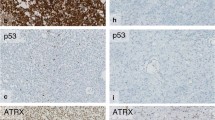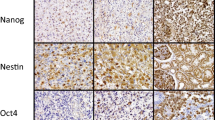Abstract
Infiltrating astrocytomas and oligoastrocytomas of low to anaplastic grade (WHO grades II and III), in spite of being associated with a wide range of clinical outcomes, can be difficult to subclassify and grade by the current histopathologic criteria. Unlike oligodendrogliomas and anaplastic oligodendrogliomas that can be identified by the 1p/19q codeletion and the more malignant glioblastomas (WHO grade IV astrocytomas) that can be diagnosed solely based on objective features on routine hematoxylin and eosin sections, no such objective criteria exist for the subclassification of grade II–III astrocytomas and oligoastrocytomas (A+OA II–III). In this study, we evaluated the prognostic and predictive value of the stem cell marker nestin in adult A+OA II–III (n = 50) using immunohistochemistry and computer-assisted analysis on tissue microarrays. In addition, the correlation between nestin mRNA level and total survival was analyzed in the NCI Rembrandt database. The results showed that high nestin expression is a strong adverse prognostic factor for total survival (p = 0.0004). The strength of the correlation was comparable to but independent of the isocitrate dehydrogenase 1/2 (IDH 1/2) mutation status. Histopathological grading and subclassification did not correlate significantly with outcome, although the interpretation of this finding is limited by the fact that grade III tumors were treated more aggressively than grade II tumors. These results suggest that nestin level and IDH 1/2 mutation status are strong prognostic features in A+OA II–III and possibly more helpful for treatment planning than routine histopathological variables such as oligodendroglial component (astrocytoma vs. oligoastrocytoma) and WHO grade (grade II vs. III).




Similar content being viewed by others
References
Aldape K, Burger PC, Perry A (2007) Clinicopathologic aspects of 1p/19q loss and the diagnosis of oligodendroglioma. Arch Pathol Lab Med 131:242–251
Davis FG, Malmer BS, Aldape K, Barnholtz-Sloan JS, Bondy ML, Brannstrom T, Bruner JM, Burger PC, Collins VP, Inskip PD, Kruchko C, McCarthy BJ, McLendon RE, Sadetzki S, Tihan T, Wrensch MR, Buffler PA (2008) Issues of diagnostic review in brain tumor studies: from the Brain Tumor Epidemiology Consortium. Cancer Epidemiol Biomark Prev 17:484–489
Chinnaiyan P, Wang M, Rojiani AM, Tofilon PJ, Chakravarti A, Ang KK, Zhang HZ, Hammond E, Curran W Jr, Mehta MP (2008) The prognostic value of nestin expression in newly diagnosed glioblastoma: report from the Radiation Therapy Oncology Group. Radiat Oncol 3:32
Ehrmann J, Kolar Z, Mokry J (2005) Nestin as a diagnostic and prognostic marker: immunohistochemical analysis of its expression in different tumours. J Clin Pathol 58:222–223
Ma YH, Mentlein R, Knerlich F, Kruse ML, Mehdorn HM, Held-Feindt J (2008) Expression of stem cell markers in human astrocytomas of different WHO grades. J Neurooncol 86:31–45
Maderna E, Salmaggi A, Calatozzolo C, Limido L, Pollo B (2007) Nestin, PDGFRbeta, CXCL12 and VEGF in glioma patients: different profiles of (pro-angiogenic) molecule expression are related with tumor grade and may provide prognostic information. Cancer Biol Ther 6:1018–1024
Almqvist PM, Mah R, Lendahl U, Jacobsson B, Hendson G (2002) Immunohistochemical detection of nestin in pediatric brain tumors. J Histochem Cytochem 50:147–158
Mangiola A, Lama G, Giannitelli C, De Bonis P, Anile C, Lauriola L, La Torre G, Sabatino G, Maira G, Jhanwar-Uniyal M, Sica G (2007) Stem cell marker nestin and c-Jun NH2-terminal kinases in tumor and peritumor areas of glioblastoma multiforme: possible prognostic implications. Clin Cancer Res 13:6970–6977
Wei LC, Shi M, Cao R, Chen LW, Chan YS (2008) Nestin small interfering RNA (siRNA) reduces cell growth in cultured astrocytoma cells. Brain Res 1196:103–112
Yang XH, Wu QL, Yu XB, Xu CX, Ma BF, Zhang XM, Li SN, Lahn BT, Xiang AP (2008) Nestin expression in different tumours and its relevance to malignant grade. J Clin Pathol 61:467–473
Dahlrot RH, Hermansen SK, Hansen S, Kristensen BW (2013) What is the clinical value of cancer stem cell markers in gliomas? Int J Clin Exp Pathol 6:334–348
Wan F, Herold-Mende C, Campos B, Centner FS, Dictus C, Becker N, Devens F, Mogler C, Felsberg J, Grabe N, Reifenberger G, Lichter P, Unterberg A, Bermejo JL, Ahmadi R (2011) Association of stem cell-related markers and survival in astrocytic gliomas. Biomarkers 16:136–143
Arai H, Ikota H, Sugawara K, Nobusawa S, Hirato J, Nakazato Y (2012) Nestin expression in brain tumors: its utility for pathological diagnosis and correlation with the prognosis of high-grade gliomas. Brain Tumor Pathol 29:160–167
Colin C, Virard I, Baeza N, Tchoghandjian A, Fernandez C, Bouvier C, Calisti A, Tong S, Durbec P, Figarella-Branger D (2007) Relevance of combinatorial profiles of intermediate filaments and transcription factors for glioma histogenesis. Neuropathol Appl Neurobiol 33:431–439
Tohyama T, Lee VM, Rorke LB, Marvin M, McKay RD, Trojanowski JQ (1992) Nestin expression in embryonic human neuroepithelium and in human neuroepithelial tumor cells. Lab Investig J Tech Methods Pathol 66:303–313
Dahlstrand J, Collins VP, Lendahl U (1992) Expression of the class VI intermediate filament nestin in human central nervous system tumors. Cancer Res 52:5334–5341
Strojnik T, Rosland GV, Sakariassen PO, Kavalar R, Lah T (2007) Neural stem cell markers, nestin and musashi proteins, in the progression of human glioma: correlation of nestin with prognosis of patient survival. Surg Neurol 68:133–143 (discussion 143–134)
Zhang M, Song T, Yang L, Chen R, Wu L, Yang Z, Fang J (2008) Nestin and CD133: valuable stem cell-specific markers for determining clinical outcome of glioma patients. J Exp Clin Cancer Res 27:85
Louis DN, Ohgaki H, Wiestler OD, Cavenee WK, Burger PC, Jouvet A, Scheithauer BW, Kleihues P (2007) The 2007 WHO classification of tumours of the central nervous system. Acta Neuropathol 114:97–109
Dubbink HJ, Taal W, van Marion R, Kros JM, van Heuvel I, Bromberg JE, Zonnenberg BA, Zonnenberg CB, Postma TJ, Gijtenbeek JM, Boogerd W, Groenendijk FH, Smitt PA, Dinjens WN, van den Bent MJ (2009) IDH1 mutations in low-grade astrocytomas predict survival but not response to temozolomide. Neurology 73:1792–1795
Metellus P, Coulibaly B, Colin C, de Paula AM, Vasiljevic A, Taieb D, Barlier A, Boisselier B, Mokhtari K, Wang XW, Loundou A, Chapon F, Pineau S, Ouafik L, Chinot O, Figarella-Branger D (2010) Absence of IDH mutation identifies a novel radiologic and molecular subtype of WHO grade II gliomas with dismal prognosis. Acta Neuropathol 120:719–729
Hartmann C, Hentschel B, Wick W, Capper D, Felsberg J, Simon M, Westphal M, Schackert G, Meyermann R, Pietsch T, Reifenberger G, Weller M, Loeffler M, von Deimling A (2010) Patients with IDH1 wild type anaplastic astrocytomas exhibit worse prognosis than IDH1-mutated glioblastomas, and IDH1 mutation status accounts for the unfavorable prognostic effect of higher age: implications for classification of gliomas. Acta Neuropathol 120:707–718
Thota B, Shukla SK, Srividya MR, Shwetha SD, Arivazhagan A, Thennarasu K, Chickabasaviah YT, Hegde AS, Chandramouli BA, Somasundaram K, Santosh V (2012) IDH1 mutations in diffusely infiltrating astrocytomas: grade specificity, association with protein expression, and clinical relevance. Am J Clin Pathol 138:177–184
Hatanpaa KJ, Burger PC, Eshleman JR, Berg KD (2003) Molecular diagnosis of oligodendroglioma in paraffin sections. Lab Investig 83:419–428
Madhavan S, Zenklusen JC, Kotliarov Y, Sahni H, Fine HA, Buetow K (2009) Rembrandt: helping personalized medicine become a reality through integrative translational research. MCR 7:157–167
Horbinski C, Kelly L, Nikiforov YE, Durso MB, Nikiforova MN (2010) Detection of IDH1 and IDH2 mutations by fluorescence melting curve analysis as a diagnostic tool for brain biopsies. JMD 12:487–492
Chen HL, Yuh CH, Wu KK (2010) Nestin is essential for zebrafish brain and eye development through control of progenitor cell apoptosis. PLoS ONE 5:e9318
Park D, Xiang AP, Mao FF, Zhang L, Di CG, Liu XM, Shao Y, Ma BF, Lee JH, Ha KS, Walton N, Lahn BT (2010) Nestin is required for the proper self-renewal of neural stem cells. Stem Cells 28:2162–2171
Acknowledgments
Supported by NIH R01NS065195-01A1, R01NS062080, the Department of Pathology, and the Annette G. Strauss Center for Neuro-oncology, University of Texas Southwestern Medical Center (UTSW). We thank Ping Shang, Mohd Alfaraj, and Christie Sheppard for expert technical assistance, Niccole Williams and Agatha Villegas for outstanding administrative professional services, and Alejandra Madrigales and the Tumor Registrar’s Office staff, Simmons Cancer Center at the UT Southwestern Medical Center, for help with the collection of the follow-up data.
Conflict of interest
The authors declare that they have no conflict of interest.
Ethical standards statement
The authors declare that the experiments comply with the current laws of the country in which they were performed.
Author information
Authors and Affiliations
Corresponding author
Additional information
Tianshen Hu and Vamsidhara Vemireddy have contributed equally to this work.
Electronic supplementary material
Below is the link to the electronic supplementary material.
Rights and permissions
About this article
Cite this article
Hatanpaa, K.J., Hu, T., Vemireddy, V. et al. High expression of the stem cell marker nestin is an adverse prognostic factor in WHO grade II–III astrocytomas and oligoastrocytomas. J Neurooncol 117, 183–189 (2014). https://doi.org/10.1007/s11060-014-1376-7
Received:
Accepted:
Published:
Issue Date:
DOI: https://doi.org/10.1007/s11060-014-1376-7




